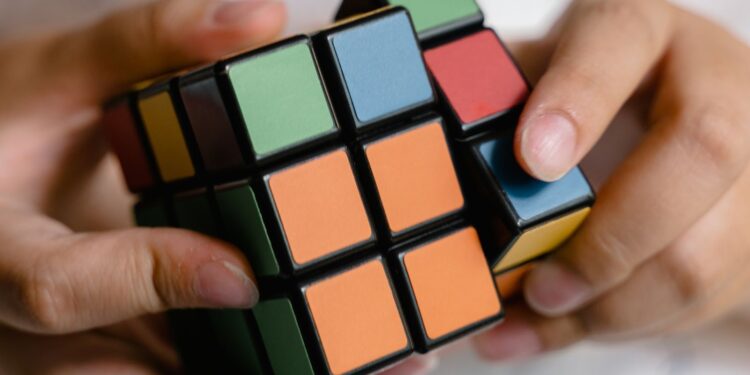The Blindfolded Cube Algorithm is a sequence of moves used to solve a Rubik’s Cube without looking at it. The algorithm is a series of mentally calculated activities that allow the solver to solve the cube purely based on touch and intuition.
The algorithm works by first solving one side of the cube, then orienting the edges of the adjacent sides, and finally solving the remaining layers using intuitive movements rather than memorized algorithms.
While solving the cube with a blindfold on may seem daunting, with practice and patience, anyone can master the blindfolded cube algorithm and impress their friends with their Rubik’s Cube-solving skills.
Pro Tip:Before attempting the Blindfolded Cube Algorithm, ensure you understand the classic Rubik’s Cube solution algorithm and have practiced solving the cube multiple times.
Understanding the Algorithm
The blindfolded cube algorithm solves the Rubik’s cube without looking. It may sound impossible, but it is surprisingly achievable with the right knowledge and practice. Some of the world’s fastest Rubik’s cube solvers can solve the cube this way.
This article will examine the blindfolded cube algorithm and how it can solve the Rubik’s cube quickly and effectively.
The basics of solving a Rubik’s cube
Solving a Rubik’s cube may seem daunting, but understanding the algorithm and practicing the blindfolded cube algorithm can make it achievable.
Here are the basics steps to solving a Rubik’s cube:
1. Start with one side of the cube and solve it completely.
2. Move on to the adjacent side and solve that too.
3. If you get stuck, remove the cube and reassemble it.
4. Practice the algorithm – R U R’ U’ – on a solved cube to master it.
5. Once you have it memorized, use the algorithm to solve the first two layers of the cube.
6. Finally, use the algorithm to align the pieces on the final layer to reveal the solved Rubik’s cube.
Pro Tip: Don’t get discouraged if you don’t solve it on the first try! Keep practicing, and eventually, you’ll get the hang of it.
What is the blindfolded cube algorithm?
The blindfolded cube algorithm is a methodology that helps solve a Rubik’s Cube puzzle without looking at it. It involves using specific moves and algorithms to decipher the mystery while blindfolded. This technique is intriguing and challenging to perform, requiring practice and patience.
Here are a few examples of the algorithms used in a blindfolded cube to solve
AlgorithmDescription
Old Pochmann Step-by-step algorithm for solving the Rubik’s Cube while blindfolded. Utilizes unique combinations of moves like “U, D, L, R, F, and B” to place the cubies in the right position.
M2 Involves using the M2 move followed by various U, D, L, R, F, and B moves to solve the puzzle.
The blindfolded cube algorithm can be a fun and engaging way to solve a Rubik’s cube puzzle, but it requires a lot of practice and memorization of various algorithms. Pro Tip – Start with a small portion of the cube and work your way up to the entire puzzle.

The benefits and drawbacks of blindfolded solving
Blindfolded solving of Rubik’s cube has benefits and drawbacks that every cuber must know before attempting it. The blindfolded cube algorithm involves memorizing its position before scrambling and solving it while being blindfolded.
The benefits of blindfolded solving include increased spatial reasoning, memorization skills, and a sense of accomplishment. However, blindfolded solving requires intensive practice, dedication, and patience.
The drawbacks of blindfolded solving include the following:
- There is a high chance of errors and mistakes.
- The need for extensive memorization and concentration.
- The possibility of getting stuck or frustrated during the process.
Hence, weighing both the benefits and drawbacks before deciding to pursue blindfolded solving in cubing is essential.
Pro Tip: Blindfolded solving is a challenging yet rewarding skill that takes time and
dedication to master. Always start with simple techniques and gradually work yourself up to more challenging algorithms.
The Mechanics of the Algorithm
The blindfolded cube algorithm is a popular technique for solving the Rubik’s Cube puzzle faster. This algorithm aims to solve the cube with only one hand and without seeing the pieces. The algorithm is based on breaking down bigger movements into smaller and more precise twists and turns.
In this article, we will explore the mechanics of the algorithm and how it works.
The setup of a blindfolded solve
The Blindfolded Cube Algorithm is an advanced technique skilled Rubik’s cube solvers use to solve the cube without looking at it. Here are the mechanics of how the blindfolded solve is set up.
1. Memorization2. Set-up3. Execution
The first step is to memorize the cube’s scrambled state. This involves breaking the cube into smaller segments and remembering them in order. Once the cube is learned, the solver sets up the cube in a specific orientation based on the memorized sequence. This involves performing a series of moves to get the cube into the correct position. After the setup, the solver performs activities based on the memorized sequence without looking at the cube. The goal is to get the cube to its solved state.
The Blindfolded Cube Algorithm is a complex process and requires extensive practice and memorization skills to perform successfully.
The execution and memorization of algorithms
The blindfolded cube algorithm is a complex sequence of moves that require both execution and memorization skills to master.
Here are the mechanics and steps to memorize the algorithm:
FirstStart by familiarizing yourself with the algorithm notation and the basic moves involved in solving a Rubik’s cube.
NextBreak, down the algorithm into smaller sections and practice executing them one at a time until you have memorized the entire sequence.
It is essential to practice the algorithm repeatedly to internalize the muscle memory needed to execute the moves smoothly and quickly without looking.
Consistency in execution is small, critical errors can derail the entire sequence.
LastlyTry, try to understand the algorithm’s logic, which can help in memorizing it effectively.
With enough practice and patience, you can master the blindfolded cube algorithm and impress your friends with Rubik’s cube skills.
Pro tip: Visualization is also an integral part of memorizing algorithms. Try breaking the algorithm into visual patterns based on the cube’s colors or the movement of the hands. This technique can help you remember the sequence more efficiently.
The common algorithms used in blindfolded solving
Blindfolded solving of the Rubik’s Cube requires using specific algorithms that can help a solver navigate the solving process without actually seeing the cube. Several algorithms are commonly used in blindfolded solving, each serving a unique purpose in getting the cube to its solved state.
Some common algorithms include the Old Pochmann method, a multi-cycle permutation algorithm, and the M2 method, which uses two wide moves. Another important algorithm used in blindfolded solving is the T-permutation, which simultaneously swaps three corners or edges. Finally, the blindfolded cube algorithm is a complex series of moves used to solve the Rubik’s Cube while blindfolded.
By mastering these algorithms, a skilled Rubik’s Cube solver can solve the cube without seeing it, adding an exciting and challenging layer to the complex puzzle.
Developing Skills for Blindfolded Solving
Solving a Rubik’s cube without looking at it is a difficult and unique challenge. The blindfolded cube algorithm requires time and practice to master but is an extremely satisfying achievement once you can easily memorize the moves and execute them.
This article will discuss the steps needed to excel in the blindfolded cube algorithm and the techniques for improving your solving skills.
Practice techniques for memorization
One of the essential techniques for effective memorization is the memory palace or method of loci. This technique involves associating pieces of information with specific locations in a familiar place, such as a childhood home, a well-known park, or even a virtual setting like a video game world. Another technique for memorization is visualization, which involves creating mental images of the information you need to remember. You can also turn the data into a song or a poem to make it more memorable.
The blindfolded cube algorithm is used by advanced Rubik’s Cube solvers who memorize algorithms to solve the cube while blindfolded. To master this technique, advanced memorization skills are required. Using the loci or visualization technique can help solvers remember the algorithms and perform the blindfolded solution effectively. Make sure to practice for accuracy and speed in memorizing the steps.
Tips for increasing speed and accuracy
The blindfolded cube algorithm is a complex process that requires both speed and accuracy to complete successfully. Here are five tips that can help you increase both:
1. Practice regularly: The more you practice, the more comfortable you’ll be with the algorithm and the faster and more accurate you’ll become.
2. Memorize the algorithm: Memorize the algorithm so you can recall it without thinking about it. This helps you solve the cube quickly and with minimal errors.
3. Get your fingers moving: Move your fingers quickly and confidently. It’s not about being gentle. The faster and more confident you are in finger movements, the better.
4. Learn the cube: Understand the structure of the cube and how it operates. This will help you anticipate the moves you need to make and minimize mistakes.
5. Be patient: Take your time with the algorithm. Take your time to ensure you’re making the right moves. Speed will come with practice.
Implementing these tips can help you develop the skills you need for blindfolded solving and mastering the cube algorithm.
Common mistakes to avoid in blindfolded solving
One of the most common mistakes in blindfolded solving is relying too heavily on muscle memory rather than memorizing algorithms. This can result in errors that are difficult to detect without being able to see the cube.
Other common mistakes to avoid in blindfolded solving include:
– Poor memorization of algorithms or forgetting which algorithm applies to which case
– Misremembering the orientation of the cube or mixing up with different solved cubes
– Incomplete memorization of the sequences of moves and not being able to remember the placement of the sub-cubes (pieces)
– Lack of attention to detail or rushing through the solution.
The key to avoiding these mistakes is to practice repetition of algorithms and memorization techniques to train your brain to make correct moves without relying on muscle memory. Additionally, it is important to stay focused on the cube and maintain a calm mindset while solving, even while blindfolded.
Advanced Blindfolded Solving Techniques
The Blindfolded Cube Algorithm has become an essential part of advanced speedcubing. This algorithm considers all the movements needed to solve a cube while blindfolded and keeps track of what pieces are where to ensure that the cube is solved without looking.
This article will discuss the benefits and techniques of using the Blindfolded Cube Algorithm.
Multi-blind solving: solving multiple cubes blindfolded
Multi-blind solving, a subset of blindfolded solving, is a technique that allows for solving multiple cubes blindfolded. This technique involves memorizing algorithms for each cube and solving them using a set algorithm.
One of the most significant advancements in this technique is the invention of “The blindfolded cube algorithm.” This algorithm, developed by Stefan Pochmann, comprises 60 different moves and enables a solver to navigate all possible permutations of a Rubik’s Cube without ever uncovering their eyes.
To perform this algorithm, the solver must extensively practice memorizing and executing algorithms while blindfolded. However, with enough exercise, blindfolded cubers can solve several cubes in a row, making multi-blind solving thrilling and challenging.
Pro tip: Effective blindfolded solving requires consistent practice, strong memorization skills, and a solid understanding of Rubik’s Cube algorithms.
SpeedBLD: timed blindfolded solving competitions
SpeedBLD competitions are contests where participants must solve the Rubik’s Cube
blindfolded within a specific time while applying various advanced blindfolded solving techniques and The blindfolded cube algorithm.
Some of the essential advanced techniques used in blindfolded solving include:
1. Memorization techniques: These techniques leverage various memorization systems such as the memory palace or mnemonic devices to memorize the Rubik’s Cube orientation while blindfolded.
2. Execution techniques: Executing the memorized pattern requires advanced algorithms such as the Saratov, M2, or Ortega.
3. Review Techniques: Reviewing the cube after solving it requires different algorithms such as CMLL, OLL, PLL, or ZBLL.
As a Rubik’s cube solver aiming for blindfolded solving, you should master these techniques and practice applying them to improve your speed. Pro tip: Practice the x, y, and z-axis cube rotations during your memorization, as it can significantly reduce the number of cycles required to solve the Rubik’s cube without affecting your execution ability.

The future of blindfolded solving: potential advances in the algorithm and technique
The future of blindfolded solving is promising, with the potential for advances in algorithms and techniques to enhance the speed and accuracy of blindfolded cube solving. Developing new algorithms that can solve the cube efficiently with fewer moves is a significant advancement in this field. Advanced techniques such as multi-phase solving, commutators, and conjugations have made inserting pieces into their requisite positions much more manageable. In addition, solvers are now utilizing more efficient memorization techniques, such as letter pairs, to remember scrambled cube configurations, making it easier to predict the next moves in the blindfolded algorithm. In the future, we will likely see advancements in Artificial Intelligence (AI) that can help to anticipate actions and improve accuracy in the blindfolded cube algorithm.
In conclusion, the future of blindfolded solving is full of exciting opportunities for innovation and improvements and an exciting field to watch out for.
Pro Tip: Practicing as much as possible is crucial for mastering the art of blindfolded solving. Regular practicing will help in increasing visualization, memory, and overall speed.
Conclusion and Further Resources
A blindfolded cube algorithm is a powerful tool for solving Rubix cubes. It involves memorizing and performing specific algorithms to solve the cube. However, with practice and dedication, anyone can learn to solve a Rubik’s cube in less than a minute.
This article looks into the conclusion of the blindfolded cube algorithm and provides further resources for those who want to learn more.
Common blindfolded cube algorithms to practice
Practicing common blindfolded cube algorithms is essential for anyone looking to master the art of solving the Rubik’s cube without looking. Here are three blindfolded cube algorithms that are popular among cubers:
1. Old Pochmann: A popular algorithm that involves solving the corners first and then the edges.
2. M2: A simple two-move algorithm that swaps two edges.
3. T-perm: An algorithm used to swap three corners and three edges in one step.
Practice these algorithms regularly to improve your muscle memory and gain speed.
For those looking for further resources, The Blindfolded Cubing Handbook by Maskow is an excellent place to start. This book provides a comprehensive guide to blindfolded cubing, including tips, tricks, and algorithms for beginners and advanced cubers.
Recommended resources for improving blindfolded-solving skills
Improving blindfolded solving skills can be challenging, but with the right resources, it can be achievable. Here are some recommended resources:
1. The blindfolded cube algorithm (also known as Old Pochmann Method) is a popular method for solving the blindfolded Rubik’s cube.
2. Blindfold cubing tutorials and walkthroughs on YouTube – many effective and informative tutorial videos are available online that can help you master the technique of blindfolded cubing.
3. Blindfold cubing apps and software – numerous mobile apps and software available can help individuals improve their memory and increase mental agility while cubing blindfolded.
In conclusion, with the right resources, practice, and dedication, one can significantly improve their ability to solve a Rubik’s cube blindfolded. So, choose any of the above resources and start working on your blindfolded-solving skills today.
Pro tip: Don’t rush the process; take your time and be patient while learning new techniques.
Final thoughts on the blindfolded cube algorithm
In conclusion, the blindfolded cube algorithm presents a fascinating challenge for seasoned cube solvers looking for a new perspective on the Rubik’s cube. While it may seem daunting and difficult at first, this algorithm can be mastered with practice and patience. It requires a good understanding of the cube’s mechanics and excellent spatial awareness and memory skills. The key to success is to break the algorithm into smaller, manageable parts and practice them repeatedly until the pattern can be executed without looking.
Plenty of online resources and tutorials are available for those interested in learning more about this challenge, including forums, YouTube videos, and even mobile apps. So, if you’re up for the challenge, grab your blindfold and dive into the exciting world of the blindfolded cube algorithm!
Pro Tip: Using a cube with a matte finish and distinct colors can make recognizing patterns easier while blindfolding.
















